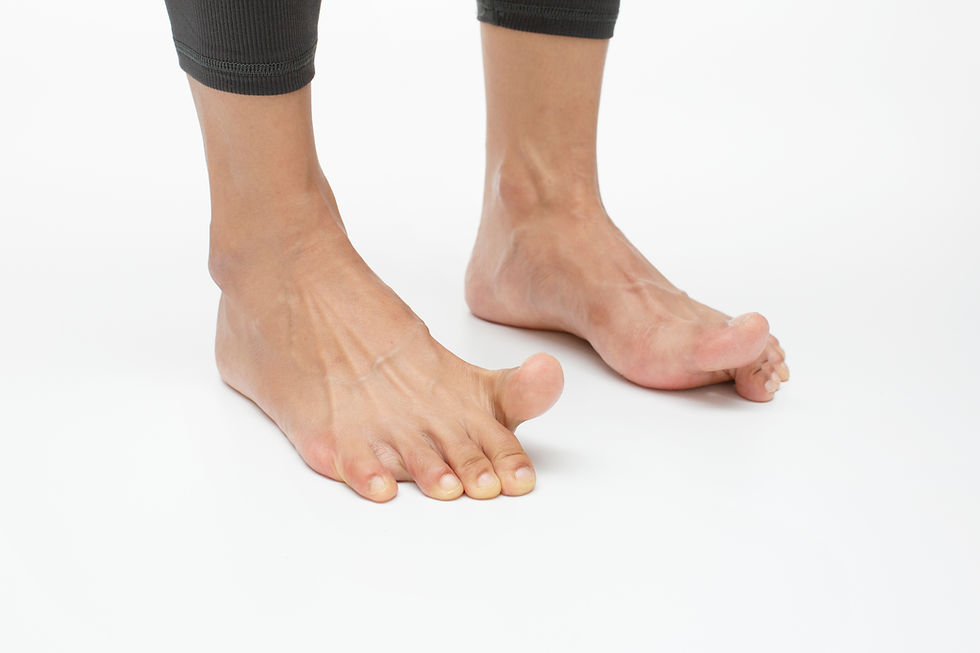Can Foot Core Strengthening Prevent Running Injuries? A Closer Look at research by Taddei et al. (2020) | Find Your Stride | Edinburgh Podiatrist
- Joshua Francois
- Jul 31
- 3 min read
Introduction
Running injuries are a persistent bane for recreational runners, with injury rates reaching up to 79% annually. The 2020 study by Taddei et al., published in the American Journal of Sports Medicine, titled 'Foot Core Training to Prevent Running-Related Injuries' tackles this issue head-on by proposing a new approach: foot core strengthening. The paper presents a rigorous, single-blind, randomised controlled trial exploring whether targeting foot muscles can reduce running-related injuries (RRIs) over a 12-month period. Here’s a critical look at what the study found—and where it falls short.

What the Study Did Well
1. High Methodological Rigor
The trial design is a standout: randomized, controlled, and with a 12-month follow-up—no small feat in sports science. The use of intention-to-treat analysis adds to its credibility, as does the use of validated tools (e.g., Foot Posture Index, Arch Index) and biomechanical assessments.
2. Clear Clinical Relevance
The intervention was highly practical: an 8-week supervised foot strengthening program followed by remote sessions. This mirrors real-world conditions and boosts the study’s external validity. More importantly, the results were impressive—those in the intervention group were 2.42 times less likely to suffer an RRI compared to controls.
3. Long-Term Tracking and Adherence
A 12-month tracking window for injury incidence is rare and commendable. The authors also achieved a high adherence rate to the intervention (88%), lending strength to the findings.
4. Mechanistic Insight
The study begins to link increased foot muscle strength to injury prevention. A significant correlation between foot strength gains and delayed time-to-injury adds a mechanistic dimension, hinting that stronger feet might absorb shock better and support more stable movement patterns.
But Not Without Limitations
1. Broad Injury Definition, Limited Subgroup Analysis
While the definition of RRIs used is standard, the study treats all injuries equally, from minor blisters to serious stress fractures. Grouping these together could mask more nuanced relationships. Would foot strength reduce knee injuries, for example, as effectively as it prevents plantar fasciitis? The study doesn’t say.
2. Limited Blinding
Despite being labeled “single-blind,” participants knew whether they were in the intervention group—introducing the possibility of placebo effects. While the authors tried to balance contact time and feedback between groups, true double-blinding is difficult to achieve in exercise interventions and remains a limitation.
3. Potential Selection Bias
By excluding runners who had recent injuries or used minimalist shoes, the study narrows its sample. This might improve internal consistency but reduces generalisability. Novice runners, or those experimenting with barefoot running, might respond differently to the same protocol.
4. Attrition and Diminishing Adherence
While initial adherence was high, compliance with remote sessions dropped to under 50% by the 12-month mark. This decline could dilute the long-term effects of the intervention and raises questions about feasibility in non-research settings.
5. Missing Biomechanical Outcomes Post-Intervention
While baseline foot function and strength were measured, there’s no report of whether these biomechanical gains were maintained over 12 months—or whether they correlated with injury type or running form. Including post-intervention gait analysis could have added valuable depth.
Implications for Runners and Clinicians
This study puts forward a compelling argument for incorporating foot-core exercises into training routines, particularly for experienced recreational runners. It’s a low-cost, low-tech intervention with potentially high reward—an appealing prospect in a sport that comes with a high injury risk.
Conclusion
Taddei et al. (2020) provide strong, novel evidence that targeted foot strengthening can reduce running-related injuries. While limitations remain—especially regarding long-term adherence and injury specificity—the study marks a promising shift in injury prevention from the traditional “top-down” (hip and core) focus to a “ground-up” strategy rooted in the foot. If you’re a runner tired of sidelining injuries, the takeaway is simple: why not start training your feet?
Find Your Stride!



Comments